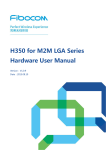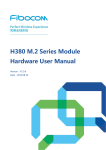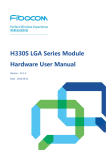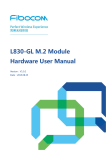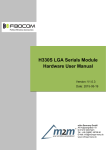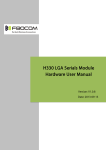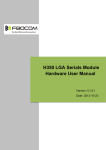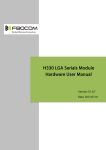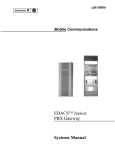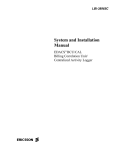Download H350 for MI LGA Series Hardware User Manual
Transcript
deguo?ng H350 for MI LGA Series Hardware User Manual Version: V1.1.0 Date: 2015-05-24 Copyright Copyright ©2015 Fibocom Wireless Inc . All rights reserved. Without the prior written permission of the copyright holder, any company or individual is prohibited to excerpt, copy any part of or the entire document, or transmit the document in any form. Attention The document is subject to update from time to time owing to the product version upgrade or other reasons. Unless otherwise specified, the document only serves as the user guide. All the statements, information and suggestions contained in the document do not constitute any explicit or implicit guarantee. Trademark The trademark is registered and owned by Fibocom Wireless Inc. Versions Version Date Remarks V1.0.0 2014-01-10 Initial Version V1.0.1 2014-01-15 Modified PIN description table V1.0.2 2014-01-16 Modified tunable antenna level V1.0.3 2014-02-22 Add H350-B50-10 description V1.0.4 2014-03-21 Update operating temperature V1.0.5 2014-04-25 1. Update operating temperature; 2. Update the product types 1. Add android/Win8 system and specification. V1.0.6 2014-06-04 2. Change the module`s power off description, add software power off about AT commands. 1. Add the description for specific types; V1.0.7 2014-08-25 2. Modify the description of UART 1, change to GPRS in current description; 3. Update POWER_ON and POWER_OFF time series , delete LPG H350 for MI LGA Series Module Hardware User Manual Page 2 of 44 state indication. V1.0.8 2014-09-12 Add H350-B50-20 and the related information. V1.0.9 2015-04-21 Add the description of “Top View” in PCB Layout; Add the description of “Top View” in PCB Layout; V1.1.0 2015-05-24 Update the description of the whole document Applicability Type No. Type 1 H350-A50-10 2 H350-B50-10 3 H350-B50-20 Note The difference of H350 series wireless module as listed below: HSDPA HSUPA (Mbps) (Mbps) 900/2100 21 5.76 850/1900 850/1900 21 5.76 850/1900 850/1700/1900 21 5.76 Model No. GSM/GPRS/EDGE Band(MHz) WCDMA Band(MHz) H350-A50-10 900/1800 H350-B50-10 H350-B50-20 H350 for MI LGA Series Module Hardware User Manual Page 3 of 44 Content 1 Foreword.................................................................................................................................................................... 7 1.1 Introduction.....................................................................................................................................................7 1.2 Reference Standards....................................................................................................................................7 2 Product Overview..................................................................................................................................................... 9 2.1 Description......................................................................................................................................................9 2.2 Specifications................................................................................................................................................. 9 2.3 Appearance..................................................................................................................................................11 3 Structure...................................................................................................................................................................12 3.1 Dimension Diagram of Structure.............................................................................................................. 12 3.2 PCB Layout Design.................................................................................................................................... 13 4 Hardware Introduction........................................................................................................................................... 14 4.1 Hardware Block Diagram...........................................................................................................................14 4.2 Pin Definition................................................................................................................................................15 4.2.1 Pin Map............................................................................................................................................. 15 4.2.2 Description of Pins...........................................................................................................................16 5 Hardware Interface.................................................................................................................................................22 5.1 Power Interface........................................................................................................................................... 22 5.1.1 Power Supply................................................................................................................................... 22 5.1.2 Power Consumption........................................................................................................................22 5.1.3 VIO..................................................................................................................................................... 26 5.1.4 VRTC................................................................................................................................................. 26 5.2 Power on/off and Reset Signal................................................................................................................. 27 5.2.1 Pin Definition of Power on/off Control Signal..............................................................................27 5.2.2 Power on Signal...............................................................................................................................27 5.2.3 Power off Signal...............................................................................................................................28 5.2.4 Reset Signal..................................................................................................................................... 30 5.3 Status Indicating Signal............................................................................................................................. 30 5.3.1 Description of Status Indicating Signal........................................................................................ 31 5.3.1.1 SMI..........................................................................................................................................31 5.3.1.2 CDI..........................................................................................................................................31 5.3.1.3 WAKE_UP............................................................................................................................. 31 5.4 USB Interface...............................................................................................................................................31 H350 for MI LGA Series Module Hardware User Manual Page 4 of 44 5.4.1 USB Interface Definition................................................................................................................. 31 5.4.2 USB Interface Application.............................................................................................................. 32 5.5 UART Interface............................................................................................................................................33 5.5.1 UART Interface Description........................................................................................................... 33 5.5.2 UART Interface Application............................................................................................................33 5.5.3 Ring Indication................................................................................................................................. 34 5.6 USIM Interface.............................................................................................................................................34 5.6.1 USIM Pins......................................................................................................................................... 34 5.6.2 USIM Interface Design....................................................................................................................35 5.6.2.1 “Normal Closed”SIM Card Circuit Design........................................................................ 35 5.6.2.2 “Normally Open” SIM Circuit Design.................................................................................35 5.6.3 Points for Attention in USIM Design............................................................................................. 36 5.6.4 USIM Hot-Plugging..........................................................................................................................36 5.6.4.1 Hardware Connection..........................................................................................................36 5.6.4.2 Software Settings................................................................................................................. 37 5.7 Digital Audio................................................................................................................................................. 37 5.7.1 I2S...................................................................................................................................................... 38 5.7.2 I2C...................................................................................................................................................... 38 5.7.3 PCM Port Description..................................................................................................................... 38 5.8 ADC Interface.............................................................................................................................................. 39 5.9 GPS_BLANKING Interface........................................................................................................................39 5.10 BODY_SAR Interface...............................................................................................................................39 5.11 Clock Interface...........................................................................................................................................39 5.12 Android/Win8 Switch Control Interface................................................................................................. 40 5.13 Other Interfaces........................................................................................................................................ 40 6 Electrical and Environmental Features...............................................................................................................41 6.1 Electrical Features...................................................................................................................................... 41 6.2 Environmental Features.............................................................................................................................41 7 RF Interface.............................................................................................................................................................42 7.1 Operating Frequency Band....................................................................................................................... 42 7.1.1 Frequency Range of Antenna....................................................................................................... 42 7.2 RF PCB Design........................................................................................................................................... 42 7.2.1 Wiring Principle................................................................................................................................ 42 7.2.2 Impedance Design...........................................................................................................................43 H350 for MI LGA Series Module Hardware User Manual Page 5 of 44 7.3 Antenna Design........................................................................................................................................... 43 7.3.1 Main Antenna Design Requirements........................................................................................... 43 H350 for MI LGA Series Module Hardware User Manual Page 6 of 44 1 Foreword 1.1 Introduction The document describes the electrical characteristics, RF performance, dimensions and application environment, etc. of H350 series wireless modules. With the assistance of the document and other instructions, developers can quickly understand the performance of H350 series wireless modules and develop products. 1.2 Reference Standards The design of the product complies with the following standards: 3GPP TS 27.007 -v6.9.0: AT command set for User Equipment (UE) 3GPP TS 27.005 -v6.0.1: Use of Data Terminal Equipment -Data Circuit terminating Equipment (DTE-DCE) interface for Short Message Service (SMS) and Cell Broadcast Service (CBS) 3GPP TS 23.040 -v6.9.0: Technical realization of Short Message Service (SMS) 3GPP TS 24.011 -v6.1.0: Point- to - Point (PP) Short Message Service (SMS) support on mobile radio interface 3GPP TS 27.010 -v6.0.0: Terminal Equipment to User Equipment (TE-UE) multiplexer protocol 3GPP TS 27.060 -v6.0.0: Packet domain; Mobile Station (MS) supporting Packet Switched services 3GPP TS 25.304-v6.10.0: User Equipment (UE) procedures in idle mode and procedures for cell re-selection in connected mode 3GPP TS 25.308 -v6.4.0: High Speed Downlink Packet Access (HSDPA); Overall description; Stage 2 3GPP TS 25.309 -v6.6.0: FDD enhanced uplink; Overall description; Stage 2 3GPP TS 23.038 -v6.1.0: Alphabets and language - specific information 3GPP TS 21.111 -v6.3.0: USIM and IC card requirements 3GPP TS 31.111 -v6.11.0 "USIM Application Toolkit (USAT)" 3GPP TS 45.002 -v6.12.0: Multiplexing and multiple access on the radio path 3GPP TS 51.014 -v4.5.0: Specification of the SIM Application Toolkit for the Subscriber Identity Module - Mobile Equipment (SIM-ME) interface 3GPP TS 51.010 -1 -v6.7.0: Mobile Station (MS) conformance specification; Part 1: Conformance specification 3GPP TS 22.004 -v6.0.0: General on supplementary services H350 for MI LGA Series Module Hardware User Manual Page 7 of 44 3GPP TS 23.090 -v6.1.0: Unstructured Supplementary Service Data (USSD); Stage 2 3GPP TS 24.008 v6.19, Mobile radio interface Layer 3 specification; H350 for MI LGA Series Module Hardware User Manual Page 8 of 44 2 Product Overview 2.1 Description H350 series modules are 3G wireless modules with high integration density, supporting GSM/GPRS/ EDGE and UMTS/HSDPA/HSUPA/HSPA+. 2.2 Specifications Specifications Operating Frequency Rang H350-B50-10/ H350-B50-20 H350-A50-10 ① UMTS (WCDMA): 900/2100MHz UMTS (WCDMA): 850/1700 /1900MHz GSM/GPRS/EDGE: 900/1800MHz GSM/GPRS/EDGE: 850/1900MHz UMTS/HSDPA/HSUPA 3GPP release 7 HSUPA 5.76Mbps (Cat 6) Data Rate HSDPA 21Mbps (Cat 14) 或 7.2Mbps (Cat 8) GSM 3GPP release 7 EDGE (E-GPRS) multi-slot class 33(296kbps DL,236.8kbps UL) GPRS multi-slot class 33(107kbps DL,85.6kbps UL) Physical Characteristics Environment Dimension : 29.8mm x 17.8mm x 2.00 mm Interface : LGA Weight : 2.5 grams Operating Temperature: -30℃ ~ +75℃ Storage Temperature: -40℃ ~ +85℃ Performance Operating Voltage Current Consumption (Typical Value) Voltage:3.3V ~ 4.5V Normal:3.8V 2mA (Sleep Mode) 3G Idle:13mA 3G Talk:500mA 2G Talk:260mA (GSM PCL5) Class 4 (2W):850/900 MHz, GSM Tx Power Class 1 (1W):1800/1900 MHz, GSM (Typical Value) Class E2 (0.5W): 850/900 MHz, EDGE Class E2 (0.4W):1800/1900 MHz, EDGE H350 for MI LGA Series Module Hardware User Manual Page 9 of 44 Class 3 (0.25W): 900/850/1700/1900/2100 MHz, WCDMA Rx Sensitivity UMTS/HSPA:-109dBm (Typical Value) GSM:-108dBm Interface Radio Frequency Interface Antenna 1 x USB 2.0,2 x UART,MUX Over UART1,Multiple Profiles over USB Function Interface SPI Support,I2C Support,I2S Support PCM,HSIC,GPIO,A/D,RTC Data Features Protocol Stack EDGE GPRS Embedded TCP/IP and UDP/IP protocol stack Multi-slot class 33 (5 Down; 4 Up; 6 Total) Coding Scheme MCS1~9 Multi-slot class 33 (5 Down; 4 Up; 6 Total) Coding Scheme CS1~4 CSD UMTS(14.4kbps),GSM(9.6kbps) USSD Support MO / MT Text and PDU modes SMS Cell broadcast Audio Audio Frequency Control Character Set Digital Audio Voice coders: EFR/HR/FR/AMR Gain Control IRA,GSM,UCS2,HEX FIBOCOM proprietary AT commands AT Command GSM 07.05 GSM 07.07 Firmware Loader Tool over USB/UART Accessories User Manual Developer Kit ① Note :1700 band only supports H350-B50-20 . H350 for MI LGA Series Module Hardware User Manual Page 10 of 44 2.3 Appearance The product appearance of H350 series wireless module is shown as below: Top view: Figure 2- 1 Top View Bottom view: Figure 2- 2 Bottom View H350 for MI LGA Series Module Hardware User Manual Page 11 of 44 3 Structure 3.1 Dimension Diagram of Structure Figure 3- 1 Dimension Diagram of Structure H350 for MI LGA Series Module Hardware User Manual Page 12 of 44 3.2 PCB Layout Design Figure 3- 2 Recommended PCB Layout (Top View) H350 for MI LGA Series Module Hardware User Manual Page 13 of 44 4 Hardware Introduction 4.1 Hardware Block Diagram Figure 4- 1 Block Diagram H350 for MI LGA Series Module Hardware User Manual Page 14 of 44 4.2 Pin Definition 4.2.1 Pin Map TOP (View) Figure 4-2 Pin Diagram H350 for MI LGA Series Module Hardware User Manual Page 15 of 44 4.2.2 Description of Pins The logic signal lever of H350 series is 1.8V. Pins of H350 series are described in the table below: Pin# Pin Name I/O Reset Value Idle Value Description Power Supply 61 VBAT I 62 VBAT I 63 VBAT I Main power supply, voltage range: 64 VBAT I 3.3V ~ 4.5V. 65 VBAT I 66 VBAT I 59 VIO O 1.8V voltage output inside the modules. 44 VRTC I/O Backup battery input/output. Power ON/OFF Signal 45 POWER_OFF I PU PU Power off control signal, internal 200K pull-up resistor 47 POWER_ON I PU PU Power on control signal, internal 200K pull-up resistor Reset Signal 46 RESET_ALL_N I PU PU I PU PU External reset signal input USIM Interface 27 USIM_CD Insert USIM card to test; active low; Internal 390K pull-up resistor. 26 USIM_VCC USIM card power supply: 1.8V or O 3.3V. 25 USIM_RST O PP PP USIM card reset signal. 24 USIM_CLK O PP PP USIM card clock signal. 23 USIM_DATA I/O PU PU USIM card data signal, internal 4.7K pull-up resistor. High Speed SIM Interface H350 for MI LGA Series Module Hardware User Manual Page 16 of 44 22 High speed SIM card USB signal + USIM_D+ (Temporarily not supported) 21 High speed SIM card USB signal - USIM_D- (Temporarily not supported) I2S Interface 18 I2S2_CLK0 O T T I2S2 serial clock SCLK0 14 I2S2_WA0 O T T I2S2 field selection signal 15 I2S2_TX O T T I2S2 serial data output 16 I2S2_RX I T T I2S2 serial data input USB Interface 31 USB_DP I/O USB data signal+ 32 USB_DM I/O USB data signal- 33 VBAT I USB Power Input I2C Interface 20 I2C_SDA I/O PU PU I2C data signal line, Internal 4.7K pull-up resistor 19 I2C_SCL O PU PU I2C clock signal line, Internal 4.7K pull-up resistor. UART1 12 UART1_RI O L L 56 UART1_DSR I T T UART1 Ring Indicator UART1 DTE Ready (not supported yet) UART1 DCEReady 55 UART1_DTR O L L (not supported yet) UART1 Carrier Detect 57 UART1_DCD O L L (not supported yet) UART1 Clear To Send 10 UART1_CTS I PU PU (not supported yet) H350 for MI LGA Series Module Hardware User Manual Page 17 of 44 UART1 Request To Send 11 UART1_RTS O L L (not supported yet) 8 UART1_TXD O PP PP UART1 Transmitted Data 9 UART1_RXD I PU PU UART1 Received Data UART2_TXD O PP PP UART2 UART2 Transmitted Data 51 (can be Reusable for SPI_MTSR) UART2 Received Data 50 UART2_RXD I PU PU (can be Reusable for SPI_MRST) ADC 41 ADC1 I WAKE_UP I ADC1, input voltage range:0~1.2V EINT 49 PU PU Interrupt of external wake-up, active low. 48 EINT2 I PU PU External interrupt, active low. 29 EINT3 I PU PU Android/Win8 switch interrupt input signal, CMOS 1.8V USB HSIC 35 34 HSIC_USB_DAT HSIC USB data signal line A (not supported yet ) HSIC_USB_STR HSIC USB pulse signal line B (not supported yet ) Clock 3 FSYS1_26M O L L 26M clock output 38 CLKOUT0 O PP PP Digital audio clock output 30 CLK32K O 32k clock output signal Tunable ANT(Not supported yet) 4 ANTCTL3 O L 5 ANTCTL2 O L L Tunable antenna control signal, bit3 with 2.5V . H350 for MI LGA Series Module Hardware User Manual L Tunable antenna control signal, bit2 Page 18 of 44 with 2.5V. 6 ANTCTL1 O L 7 ANTCTL0 O L L Tunable antenna control signal, bit1 with 1.8V L Tunable antenna control signal, bit0 with 1.8V Antenna 73 Antenna interface,impedance ANT I/O 43 SMI O L 17 CDI O PD requirement: 50 ohm. Others Sleep Mode Indicator PD Core Dump Indicator Network control signal. 54 W_DISABLE# I/O Note : can be for LPG function or 功 SPI_MRDY. But not support yet . 52 USIF3_SCLK I reserve for SPI_CLK 53 SRDY O reserve for SPI_SRDY 13 GPIO13 O GPIO13(reserve as the HSIC waking signal) 36 GPS_Blanking O L L External GPS control signal. 37 BODY_SAR I PU PU BODY_SAR detection signal NC 1 NC 2 NC 39 NC 40 NC 42 NC 58 NC GND 28 GND 60 GND H350 for MI LGA Series Module Hardware User Manual Page 19 of 44 67 GND 68 GND 69 GND 70 GND 71 GND 72 GND 74 GND 75 GND 76 GND 77 GND 78 GND 79 GND 80 GND 81 GND 82 GND 83 GND 84 GND 85 GND 86 GND 87 GND 88 GND 89 GND 90 GND 91 GND 92 GND 93 GND 94 GND H350 for MI LGA Series Module Hardware User Manual Page 20 of 44 95 GND 96 GND 97 GND 98 GND 99 GND 100 GND 101 GND 102 GND 103 GND 104 GND 105 GND 106 GND 107 GND 108 GND 109 GND 110 GND H : High Voltage Level. L : Low Voltage Level. PD : Pull-Down. PU : Pull-Up. T : Tristate. OD : Open Drain. PP : Push-Pull. H350 for MI LGA Series Module Hardware User Manual Page 21 of 44 5 Hardware Interface 5.1 Power Interface 5.1.1 Power Supply H350 modules require 3.3V~4.5V direct current power supply, which can provide the maximum GSM emission current of 2A. Input power supply requirements: Parameter Minimum Value Recommended Value Maximum Value Unit VBAT 3.3 3.8 4.5 V Points for attention in design: 1. Supply voltage fluctuation shall be lower than 300mV. 2. Minimum supply voltage drop shall be higher than 3.3V. Filter capacitor of supply circuit is designed as follows: Recommended capacitor Application Description Reduce power-supply fluctuation during phone 1000uF Supply capacitance call. The capacitance value bigger is better Filter the interference caused by clock and 10nF, 100nF Digital signal noise 8.2pF, 10pF 1800/1900/2100 MHz Filter RF interference 33pF, 39pF 850/900 MHz Filter RF interference digital signals 5.1.2 Power Consumption The power consumption as listed below: Parameter Description I OFF RTC mode I IDLE I SLEEP Condition Typical Unit Value 68 uA Idle mode(GSM) MFRMS 5 12.1 mA WCDMA DRX 8 12.5 mA Low power mode (GSM) DRX 2 1.9 H350 for MI LGA Series Module Hardware User Manual Page 22 of 44 Low power mode (WCDMA) DRX GSM850 PCL EGSM900 PCL I GSM-RMS GSM voice RMS Current DCS1800 PCL PCS1900 PCL GSM850 PCL I GSM-MAX GSM voice Peak current EGSM900 PCL DCS1800 PCL H350 for MI LGA Series Module Hardware User Manual 5 1.5 mA 9 1.5 6 1.8 8 1.8 9 1.7 5 239.00 10 81.80 15 50.10 19 46.30 5 246.7 10 91.9 15 61.2 19 57.2 0 172.2 5 82.1 10 60.3 15 57.9 0 168.80 5 70.70 10 48.80 15 46.10 5 1799.90 10 421.10 15 143.60 19 116.40 5 1738.8 10 415.9 15 135.3 19 124.2 0 1012.9 mA mA mA Page 23 of 44 PCS1900 PCL GSM850 PCL=5 GSM850 PCL=10 EGSM900 PCL=5 EGSM900 PCL=10 GPRS 1RX slot TX slot DCS1800 PCL=0 I GPRS DCS1800 PCL=10 PCS1900 PCL=0 PCS1900 PCL=10 GSM850 PCL=8 I EGPRS-RMS GSM850 PCL=15 GPRS 1RX slot EGSM900 PCL=8 EGSM900 PCL=15 H350 for MI LGA Series Module Hardware User Manual TX slot 5 348.7 10 141.5 15 110.3 0 1162.10 5 343.80 10 139.50 15 116.20 1 223.90 4 364.20 1 85.00 4 214.70 1 247.9 4 373.7 1 89 4 220.3 1 172.4 4 259.8 1 60.3 4 101.2 1 168.40 4 261.90 1 53.00 4 94.60 1 165.90 4 482.70 1 54.80 4 101.10 1 165.2 4 493.2 1 61.5 mA mA Page 24 of 44 DCS1800 PCL=2 DCS1800 PCL=10 PCS1900 PCL=2 PCS1900 PCL=10 Band1 Band2 I WCDMA -RMS WCDMA Band4 Band5 Band8 H350 for MI LGA Series Module Hardware User Manual 4 107.7 1 174.9 4 514.3 1 67.7 4 109.6 1 174.00 4 489.30 1 60.40 4 102.20 24dBm 442 0dBm 131.2 -24dBm 120.6 -50dBm 118.7 24dBm 480.00 0dBm 129.60 -24dBm 120.3 -50dBm 118.1 24dBm 494 0dBm 129 -24dBm 119 -50dBm 117 24dBm 398.7 0dBm 124.4 -24dBm 117.70 -50dBm 116.20 24dBm 421.9 0dBm 128.6 -24dBm 121.8 -50dBm 120.2 mA Page 25 of 44 5.1.3 VIO As the power supply for the digital circuit inside the module, VIO can be used as the status indicator for the module. VIO can be used as the reference level of the module’s digital signals. Parameter Minimum Value Recommended Value Maximum Value Unit VIO in operation 1.773 1.8 1.827 V 5.1.4 VRTC VRTC is the power supply of the RTC inside the module, and it can be used as the backup power signal as well. Parameters Minimum Value Recommended Value Maximum Value Unit VRTC output voltage 1.71 1.8 1.89 V 0.5 1.8 1.89 V 1.0 uA VRTC input voltage (RTC is in normal) VRTC input current (RTC is in normal) The reference design of VRTC circuit is as follows: Figure 5- 1 VRTC Reference Design Note: R8 is a current-limiting resistor, used to ensure the VRTC module works properly, free from being affected by peripheral circuits. R8≥1k ohm VRTC power consumption current<2uA The value of C9 will affect the retaining time of RTC after VBAT powers off. The retaining time of RTC can be roughly calculated by the following formula: T= (1.8-0.5)*C/1=1.3C, unit: second. Namely, if the value of C9 is 100uF, the retaining time of RTC will be around 130s. I f the RTC backup power function is not required ,VRTC pin can be floating. H350 for MI LGA Series Module Hardware User Manual Page 26 of 44 5.2 Power on/off and Reset Signal 5.2.1 Pin Definition of Power on/off Control Signal H350 wireless modules provide three control signals to start up, shut down, and reset the modules. Pins definition as listed below : Pin# Pin Name Electrical Level Description 45 POWER_OFF CMOS 1.8V Power off signal 47 POWER_ON CMOS 1.8V Power on signal 46 RESET_ALL_N CMOS 1.8V External reset signal input 5.2.2 Power on Signal After the module is connected to the power supply, the user can start up the module by setting low POWER_ON signal low. Timing sequence requirement of the startup pulse: Parameter Pulse Width Condition Minimum Value Typical Value Maximum Value Unit 100 300 3000 ms The timing sequence control is shown in the diagram below: Figure 5- 2 Timing Control H350 for MI LGA Series Module Hardware User Manual Page 27 of 44 The recommended design of POWER_ON signal is as follows: Figure 5- 3 POWER_ON Reference Design 5.2.3 Power off Signal H350 module supports two power_off modes. Through the software modes to turn off the module in general condition. If the system halted or happened exceptions, use the following hardware modes to turn off it, pull down the POWER_OFF signal. For details as listed below: Off modes Software off Hardware off Methods Condition Send AT+CPWROFF commands. Normal power_off Pull down the Only used for system halted or happens exceptions and POWER_OFF signal. the software modes cannot be used. The description of hardware power_off as follows (Pull down the POWER_OFF# signal or floating) : While pulling down the POWER_OFF# signal or floating, the modules` PMU (Power Management Unit) will be reset, then the module will get into off modes from working modes. The timing sequence requirements of the pulse are as follows: Parameter Pulse Width Condition Minimum Value Typical Value Maximum Value Unit 100 300 3000 ms H350 for MI LGA Series Module Hardware User Manual Page 28 of 44 The timing sequence diagram as follows: Figure 5- 4 Power off Timing Control Diagram The recommended design of POWER_ OFF signal is as follows: Figure 5- 5 Recommended Design of POWER_OFF# Signal H350 for MI LGA Series Module Hardware User Manual Page 29 of 44 5.2.4 Reset Signal H350 wireless modules support external reset function. It is feasible to reset the module back to the original state by the Reset Signal. When setting the Reset Signal low for 100ms, the module will be reset and restarted. When the user uses the Reset_N function, the PMU inside the module will not lose power. Note: Reset signal is a sensitive signal line. In designing PCB layout, please keep the line away from RF interference, and make it well wrapped with ground wire. And it is advised to add an anti-shaking capacitor at the place close to the module end. At the same time, Reset_N signal line shall avoid the PCB edge and the surface, then reset the ESD can be avoided. The timing sequence requirements of its pulse are as follows: Parameter Condition Pulse Width Minimum Value Typical Value Maximum Value Unit 100 300 3000 ms Recommended design: Figure 5-6 Recommended Design of Reset Circuit 5.3 Status Indicating Signal The pins of status indicating signal as listed below: Pin# Pin Name Description 54 W_DISABLE1#/LPG Close or open the network/ status index, not supported yet. 43 SMI Sleep Mode Indicator 17 CDI Core Dump Indicator 49 WAKE_UP Sleep awaking pin H350 for MI LGA Series Module Hardware User Manual Page 30 of 44 5.3.1 Description of Status Indicating Signal 5.3.1.1 SMI SMI signal description as listed below : Modes Description Sleep Mode 2.5S High; 100ms Low,repeat this Other Mode low level 5.3.1.2 CDI Indexing the module getting into the Core dump. Modes Description Normal mode Low level Core Dump High level 5.3.1.3 WAKE_UP Modes Sleep Idle/Call WAKE_UP Signal Description Low level Wake up the module from Sleep mode to Idle mode High level Keep the module in Sleep mode Low level Keep the module in Idle/Call mode High level The module will not get into Sleep mode 5.4 USB Interface 5.4.1 USB Interface Definition Pin# Pin Name I/O Description 31 USB_DP I/O USB signal+ 32 USB_DM I/O USB signal- 33 VBAT I USB power input H350 wireless modules support USB 2.0. Before connecting it to PC, it is necessary to install the related USB driver. After inserting the H350 wireless modules to PC, the USB interface will work with the driver and map H350 for MI LGA Series Module Hardware User Manual Page 31 of 44 seven ports on PC, as follows: One 3G Modem/AT port for initiating data traffic Three ports for dispatching AT Command One ports for capturing LOG information of the software Two port reserved for future use 5.4.2 USB Interface Application Reference Circuit Design: Figure 5- 7 USB Interface Reference Circuit Design T101 and T102 shall be TVS with capacitance lower than 1pF; there is no specific limitation for the capacitance of T103. VUSB pin supplies power for USB. The recommended power supply range is 2.5V ~ 5.25V. In designing VUSB, there must be input, or it cannot recognize USB port. USB_DP and USB_DM are the high-speed differential signal line, and their highest transmission rate is 480Mbps. The following requirements should be followed in designing PCB layout. USB_DP and USB_DM signal lines should have the same length, and should be parallel; avoid right angle wiring; USB_DP and USB_DM signal lines should be wrapped with GND at the ends. USB2.0 differential signal line should be laid at the signal layer closest to the ground layer. Ensure impedance matching; impedance is required to be 90ohm. H350 for MI LGA Series Module Hardware User Manual Page 32 of 44 5.5 UART Interface 5.5.1 UART Interface Description H350 wireless modules provide two UART for the users. UART1 and UART2 are all the 2-line serial port. UART1 supports AT commands. Users can download software or receive and dispatch AT through UART1. UART2 only supports part of the AT commands. Note: UART2 only supports the ordinary query function. UART2 does not support the MUX function. The interface definition of UART1 and UART2 as listed below : UART1 Pin# Pin Name I/O Description 12 UART1_RI O UART1 Ring Indicator 56 UART1_DSR I UART1 DTE Ready , not supported yet . 55 UART1_DTR O UART1 DCE Ready ,not supported yet . 57 UART1_DCD O UART1 Carrier Detect , not supported yet . 10 UART1_CTS I UART1 Clear to send , not supported yet . 11 UART1_RTS O UART1 Request to send , not supported yet . 8 UART1_TXD O UART1 Transmitted Data 9 UART1_RXD I UART1 Received Data Pin# Pin Name I/O Description 50 UART2_RXD I UART2 Received Data 51 UART2_TXD O UART2 Transmitted Data UART2 5.5.2 UART Interface Application Connect UART1 of H350 wireless module (DCE) to PC, and the signal direction of (DTE) is as follows: MCU (DTE) application Signal Direction H350 module (DCE) RXD UART1_TXD TXD UART1_RXD H350 for MI LGA Series Module Hardware User Manual Page 33 of 44 Connect UART2 of H350 wireless module (DCE) to PC, and the signal direction of (DTE) is as follows: MCU (DTE) application Signal direction H350 module (DCE) RXD UART2_TXD TXD UART2_RXD Note: the high level of the module’s UART interface is 1.8V. If it needs to connect it to 2.8V or 3.3V IO interface, it is necessary to switch the level. In design: it is recommended to use SN74LVC2G07 to switch the level from 1.8V to 3.3V. During the communication between UART1 and PC, firstly raise the level from 1.8V to 3.3V, and then, employ SP3238 to switch the level. During the communication between UART2 and PC, firstly raise the level from 1.8V to 3.3V, and then, employ SPIEX3232EEA to switch the level. Pay attention to the signal direction when switching the level. 5.5.3 Ring Indication UART1_RI signal is used to index incoming calls and SMS, and dispatch pulses to the host application. Working mode Status Default status Low level Incoming call ring 1s high level, and 1s low level, repeat this. New SMS 150ms pulse 5.6 USIM Interface H350 modules support USIM and high speed SIM cards. For 8-line intelligent USIM is not supported yet. 5.6.1 USIM Pins Pin# Pin Name I/O Function Description 26 USIM_VCC O USIM power supply signal 25 USIM_RST O USIM Reset signal 24 USIM_CLK O USIM clock signal 23 USIM_IO I/O USIM data signal 28 GND GND USIM ground signal USIM Plug-in detection signal 27 USIM_CD I The internal module has been pulled up. Low level indicates that SIM card is not inserted. High level indicates that card is inserted. H350 for MI LGA Series Module Hardware User Manual Page 34 of 44 5.6.2 USIM Interface Design 5.6.2.1 “Normal Closed”SIM Card Circuit Design Reference Circuit Design : Figure 5- 8 Reference Design of “Normally Closed” SIM Card Interface Normally closed SIM Connector: 1)Pull out SIM card, pin 7 and pin 8 will short-circuit . 2)Insert SIM card, pin 7 and pin 8 will disconnect. 5.6.2.2 “Normally Open” SIM Circuit Design Referenced Circuit Design: Figure 5- 9 Reference Design of “Normally Open” SIM Card Interface H350 for MI LGA Series Module Hardware User Manual Page 35 of 44 Normally Open SIM Connector: 1)Pull out SIM card, pin 7 and pin 8 will disconnect. 2)Insert SIM card, pin 7 and pin 8 will short-circuit Note: In order to improve EMC performance, the SIM card slot should be close to the module to the largest extent. The filter capacitor on the SIM-card signal circuit should be placed close to SIM card pin to the largest extent. ESD device (like TVS) shall be added to the SIM-card signal circuit protection. ESD device should be placed close to SIM card pin. USIM_IO has been pulled up inside the module. No need to pull it up again from the outside. USIM_CD signal connection supports hot-plugging; active low. If the module detects the signal at low level, it means there is a card in the module. 5.6.3 Points for Attention in USIM Design SIM card interface design is very important for the normal operation of the module and SIM card. The following points need to be complied with during the design: SIM card layout and wiring must keep away from EMI interference source, like RF antenna and digital switch signal. In order to ensure signal completeness, the wire distance between the module and SIM card should not exceed 100mm. In order to avoid mutual interference, USIM_CLK and USIM_IO signals should be separated in wiring. It would be best to wrap them with ground wire respectively. SIM card signal line should be protected with ESD. These protective devices should have small capacitance (like Zener diode, etc.). Users are recommended to select ESD devices with equivalent capacitance lower than 33pF. During layout, ESD device should be close to the SIM card interface. 5.6.4 USIM Hot-Plugging H350 supports SIM card status-detection function. This function allows the hot-plugging of SIM card. 5.6.4.1 Hardware Connection SIM card hot-plugging function needs to work with USIM_CD signal . USIM_CD will be at low level without SIM card; after inserting SIM card, USIM_CD will be at high level. Note : For “Normal closed” SIM card, as shown in the figure5-8, USIM_CD signal line is connected to U2’s Pin8 (SW2), and Pin7 (SW1) is connected to the ground. When the SIM card is not inserted, SW2 H350 for MI LGA Series Module Hardware User Manual Page 36 of 44 and SW1 short circuit, SW2 will be at low level. When the SIM card is inserted, SW2 and SW1 will be disconnected, USIM_CD level will be pulled up. For “Normal opened” SIM card, as shown in the figure5-9, USIM_CD signal line is connected to U2’s Pin8 (SW2), and Pin7 (SW1) will be pulled up 4.7K resistor . When the SIM card is not inserted, SW2 and SW1 will be disconnected, then SW2 will be at low level. When the SIM card is inserted, SW2 and SW1 will short circuit, USIM_CD level will be pulled up. 5.6.4.2 Software Settings “+MSMPD” configures AT command for the SIM card status-detection function. If set AT+MSMPD=0, SIM card status-detection function will be closed, and the module will not detect USIM_CD signal. If set AT+MSMPD=1, SIM card status-detection function will be in opened, and the module will detect if the SIM card is inserted by USIM_CD Pin. If USIM_CD is at low level, which indicates SIM card is inserted, the module will automatically register it to the network. If USIM_CD is at high level, which indicates SIM card is not inserted, the module will not register it to the network. Note: the default of +MSMPD parameter is “1”.USIM_CD is only the hot-plug detection. The module will not detect the USIM_CD at the first power on ( No matter how the level status of SIM_CD, the module will read the SIM card and register network at the first power on ). 5.7 Digital Audio H350M.2 module supports digital audio I2S interface that supports normal I2S mode and PCM mode. I2S interface level is 1.8V on average. I2S signal description: Pin# Pin Name I/O Description 18 I2S2_CLK0 O Bit Clock 14 I2S2_WA0 O Left and right channel clock (LRCK) 15 I2S2_TX Os Serial data output 16 I2S2_RX I Serial data input 20 I2C_DATA I/O I2C control signal input/output 19 I2C_SCL O I2C control clock signal H350 for MI LGA Series Module Hardware User Manual Page 37 of 44 5.7.1 I2S H350 Signal Direction Audio CODEC I2S Port I2S2_CLK0 I2S_CLK I2S2_WA0 I2S_LRCK I2S2_RX I2S_SDOUT I2S2_TX I2S_SDIN CLKOUT0 I2S_MCLK 5.7.2 I2C H350 Signal Direction Audio CODEC I2C Port I2C_SDA I2C_SDA I2C_SCL I2C_SCL Description: I2S interface can be configured as client-server work mode. Suitable for various audio sampling frequencies(48KHz, 44.1KHz, 32KHz, 24KHz, 22.5KHz, 16KHz, 12KHz, 11.025KHz and 8KHz). 5.7.3 PCM Port Description H350 Signal Direction Audio CODEC PCM Port I2S2_CLK0(PCM_CLK,PCM clock signal) PCM_CLK(PCM clock signal) I2S2_WA0(PCM_SYNC,PCM frame PCM_SYNC(PCM frame synchronization signal) synchronization signal) I2S2_RX(PCM_DIN,PCM data input ) PCM_DOUT(PCM data output) I2S2_TX(PCM_DOUT,PCM data output ) PCM_DIN(PCM data input ) Note: PCM interface can be configured as client-server work mode. Support short frame synchronization at 16, 32, 48, and 64 bit mode. Support burst and continuous mode transmission. Suitable for various audio sampling frequencies(48KHz, 44.1KHz, 32KHz, 24KHz, 22.5KHz, 16KHz, 12KHz, 11.025KHz and 8KHz). H350 for MI LGA Series Module Hardware User Manual Page 38 of 44 5.8 ADC Interface H350 supports ADC detection, with precision of 10bit. ADC input voltage is required to be 0~1.2V. ADC signal description: Pin# Pin Name I/O Description 41 ADC1 I ADC input 5.9 GPS_BLANKING Interface Output the low level by default. While the module works in GSM bands, GPS Blanking will output the pulse signal that synchronized with GSM burst timing sequence. Because of the GSM TX will interface GPS signal receiving, suggest to close GPS or stop GPS data receiving while AP has detected the GPS_BLANKING pulse signal. Pin# Name I/O Description 36 GPS_BLANKING O External GPS control signal 5.10 BODY_SAR Interface H350 supports BODY_SAR function . BODY_SAR is input signal(this signal is output by AP-side) and with high level by default. Low level is available. AP can detect the human body`s nearing through distance sensor, then output the BODY_SAR signal with low level. Once the module detect the signal through interrupt detection, it will reduce the TX power. The reduced threshold value can be set by AT commands. Pin# Name I/O Description 37 BODY_SAR I BODY_SAR detection . 5.11 Clock Interface H350 supports 2 clock output with 26MHz, one clock output with 32KHz . Pin# Pin Name I/O Description 3 FSYS1_26M O 26M clock output(recommend for external GPS) 38 CLKOUT0 O 26MHz main clock output(recommend for I2S) 30 CLK32K O 32K clock output H350 for MI LGA Series Module Hardware User Manual Page 39 of 44 Note : compare to the FSYS1_26M and CLKOUT0, the accuracy of clock output is higher . 5.12 Android/Win8 Switch Control Interface H350 supports the Win8/Android dual system switch. Check and achieve the switch function through interrupt signal EINT3. Pin# Name I/O Description 29 EINT3 I The detection signal of Android/Win8 switching, CMOS 1.8V The function definition of EINT3 signal as listed below: No . EINT3 1 High/Floating 2 Low Function Android system supports, the module`s `USB ports shall set as 7ACM modes. Win8 system supports, the module`s USB ports shall set as MBIM mode. Note: 1. Check and achieve the Win8/Android system switch through EINT3 level while module starting . Keep the EINT3 level stability during starting. 2. Check and achieve the Win8/Android system switch through EINT3 rising edge/ falling edge while the module starting. The debouncing time sets as 100ms. The module will reboot once meeting all the requirements and switch different system supports. 5.13 Other Interfaces The module does not support GPIO and HSIC yet . H350 for MI LGA Series Module Hardware User Manual Page 40 of 44 6 Electrical and Environmental Features 6.1 Electrical Features The table below lists the range of H350’s electrical characteristics: Parameters Minimum Value Maximum Value Unit Power supply signal 0 4.5 V Digital signal 0 1.9 V 6.2 Environmental Features This table below shows the environmental features of H350: Parameters Minimum Value Maximum Value Unit Operational Temperature -30 +75 °C Storage Temperature -40 +85 °C H350 for MI LGA Series Module Hardware User Manual Page 41 of 44 7 RF Interface 7.1 Operating Frequency Band 7.1.1 Frequency Range of Antenna Operating Band Tx Rx UMTS 2100 (Band I IMT) 1920–1980 MHz 2110–2170 MHz UMTS 1900 (Band II IMT) 1850–1910 MHz 1930–1990 MHz UMTS 1700 (Band IV AWS) 1710 –1755 MHz 2110 –2155 MHz UMTS 850 (Band V 824–849 MHz 869–894 MHz 880–915 MHz 925–960 MHz GSM 850 824–849 MHz 869–894 MHz GSM 900 880–915 MHz 925–960 MHz DCS 1800 1710–1785 MHz 1805–1880 MHz PCS 1900 1850–1910 MHz 1930–1990 MHz UMTS 900 (Band VIII IMT) IMT) 7.2 RF PCB Design 7.2.1 Wiring Principle Because H350 has no RF connector, the user needs to connect a length of RF line to the antenna, or design a connector on the board. So, it is recommended to use microstrip line for RF line. It should be as short as possible with loss controlled below 0.2dB, and impedance of 50 ohm. Reserve a π circuit (the earth terminals of the two parallel devices should be directly connected to the main ground) between H350 module and the antenna connector (or feed point) for antenna tuning. Figure 7- 1π-type Circuit H350 for MI LGA Series Module Hardware User Manual Page 42 of 44 7.2.2 Impedance Design The impedance of RF signal line of antenna interface needs to be controlled at 50 ohm. 7.3 Antenna Design 7.3.1 Main Antenna Design Requirements (1) Antenna efficiency Antenna efficiency is the ratio of the input power and radiant power. Because of the antenna’s return loss, material loss and coupling loss, the radiant power is always lower than the input power. The ratio is recommended to be > 40% (–4dB). (2) S11 or VSWR S11 shows the matching degree of the antenna’s 50 ohm impedance, which affects antenna efficiency to a certain extent. It is feasible to use VSWR testing method to measure the index. It is recommended that S11 < –10dB. (3) Polarization Polarization is the rotation direction of the electric field of the antenna at the direction of the largest radiation. It is recommended to use linear polarization; for diversity antenna, it is recommended to use different polarization directions from that of the main antenna. (4) Radiation pattern Radiation pattern refers to the electromagnetic field intensity at various directions in the far field of the antenna. Half-wave doublet antenna is the perfect terminal antenna. In the case of built-in antenna, it is recommended to use PIFA. Antenna area: H 6mm * W 10mm * L 100mm. It is recommended to use PIFA or IFA. Antenna radiation direction: Omni-directional. (5) Gain and directivity Antenna directivity refers to the electromagnetic field intensity at various directions of the electromagnetic wave. Gain is the combination of the antenna efficiency and antenna directivity. It is recommended that antenna gain ≤ 2.5dBi. (6) Interference In addition to antenna performance, other interference from the PCB will also affect the module performance. In order to ensure the high performance of the module, the interference must be under H350 for MI LGA Series Module Hardware User Manual Page 43 of 44 control. Suggestions: keep speaker, LCD, CPU, FPC wiring, audio circuit, and power supply away from the antenna; add appropriate separation and shielding devices, or conduct filtering on the path. (7) TRP/TIS TRP (Total Radiated Power): W900/W850/W1700/W1900/W2100>19dBm GSM850/GSM900>28dBm DCS1800/PCS1900>25dBm TIS (Total Isotropic Sensitivity): W900/W850<-102dBm W1700/W1900/W2100<-103dBm GSM850/GSM900<-102dBm DCS1800/PCS1900<-102dBm H350 for MI LGA Series Module Hardware User Manual Page 44 of 44












































